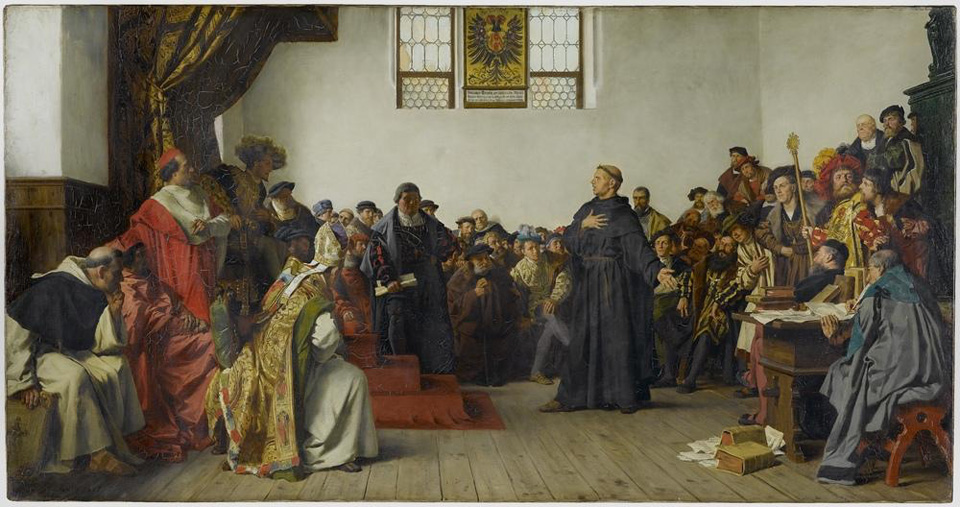
The Protestant Reformation is often dated to October 31, 1517, in Wittenberg, Saxony, north of Leipzig in what is now Germany. On that date Martin Luther sent his Ninety-Five Theses on the Power and Efficacy of Indulgences to the Archbishop of Mainz. The theses criticized the Roman Catholic Church and the papacy, slamming the selling of indulgences and doctrinal policies about purgatory, last judgment, and papal authority.
In the following years Luther wrote works on the Catholic devotion to Virgin Mary, intercession and worship of the saints (for which he found no basis in the Bible), the sacraments, mandatory clerical celibacy, monasticism, further on the authority of the pope, ecclesiastical law, censure and excommunication, the role of secular rulers in religious matters, and the relationship between Christianity and the law.
At the Diet of Worms in 1521 Luther was summoned to recant his work but he refused and was sent away. The German emperor Charles V, although himself a loyal Catholic, simply did not know what to do with him, as Reformation ideas had already spread widely throughout his realm. Luther retreated to Wartburg castle, near Eisenach, where he remained for years translating the Bible into German to make it more accessible to a general readership.
Reformers made heavy use of inexpensive pamphlets as well as vernacular Bibles using the revolutionary new Gutenberg printing press, so there was swift movement of both ideas and documents.
The Protestant Reformation’s schism from the Catholic Church had significant antecedents in such rebels as Jan Hus, Peter Waldo, and John Wycliffe. Over the course of the next century, much of central and northern Europe adopted national forms of the Reformation, largely grouped into Lutheran and Calvinist movements. The new movement influenced the Church of England decisively after 1547, although Henry VIII had already broken with the pope in the early 1530s.
Protestant doctrinal changes emphasized a complete reliance on Scripture as a source of proper belief (as opposed to papal pronouncements) and the belief that faith in Jesus, and not good works, is the only way to obtain God’s pardon for sin. Though the core motivation behind these changes was theological, many other factors played a part, including the rise of nationalism and nation states, eroding faith in the papacy, rampant corruption in the Roman church, the impact of humanism, and the new learning of the Renaissance that questioned much traditional thought in science, letters and arts. The very emergence of perspective in painting showed that the world could be seen from different points of view and affirmed the individuality of the artist.
Challenges to papal authority carried broad implications about the nature of human beings. If the pope was the “Vicar of Christ,” anointed by God Himself as the worldly lord of the universe, then cardinals, bishops and clergy down to the local parish priest were themselves bearers of God’s word. According to the “divine right of kings,” secular rulers were both total autocrats and heads of their national churches. Tension arose between loyalty to the church and loyalty to the nations. Within other social institutions and relationships, including the family, the father ruled the house, owner ruled the slave, the boss controlled the worker, the male exercised control over the female, and as evidenced by the principle of primogeniture, the elder dominated the younger.
The Reformation implicitly questioned those hierarchies. If human beings were equal before God with equal access to Scripture and to salvation, the long path toward political and social equality was now open, including eventually equality between the sexes. Rule by royal decree began to crumble as the new capitalist class and the professional guilds used their clout to establish new standards of practice in the economic and political sphere. Over time, in western Europe, for example, royalty became little more than decorative, exerting little actual political power.
By the mid-16th century the Protestant attacks on Rome led to widespread depictions, in both word and imagery, of “good” against “bad” church. This intense rivalry between factions of Christian belief systems has survived for 500 years.
What factors led to the adoption of Reformation thinking? Among them, the presence of a printing press in a city by 1500, and the presence of a competitive media market; greater political autonomy, especially where Protestant reformers enjoyed princely patronage; proximity to neighbors who adopted Protestantism; and cities with higher numbers of students enrolled in universities. Regions that were poor but had great economic potential and repressive political institutions were more likely to seek reform.
Places less likely to adopt Protestantism include cities with strong cults of saints, or where there were bishoprics or monasteries, and where primogeniture was practiced.
For its time the Reformation was an expression of Renaissance humanism, a giant step toward freedom. The world owes an incalculable debt to those reformers of 500 years ago. But much has changed since then. It can no longer be said that churches on either side of the Reformation are “good” or “bad.” Repressive practices persist in almost every faith tradition; and yet many of these same traditions also profess social justice and liberation. Freedom movements have emerged out of churches, mosques and synagogues, not to mention humanistic and nontheistic belief systems. Faith continues as the prime motivating factor in millions of people’s lives. The struggle to allow religion to help advance the human condition continues to our day.
Adapted from Wikipedia.












Comments